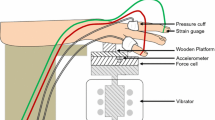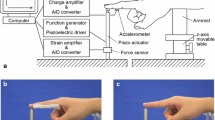Abstract
Purpose
This study investigated how the vasoconstriction induced by vibration depends on the frequency of vibration when the vibration magnitude is defined by individual thresholds for perceiving vibration [i.e. sensation levels (SL)].
Methods
Fourteen healthy subjects attended the laboratory on seven occasions: for six vibration frequencies (8, 16, 31.5, 63, 125, or 250 Hz) and a static control condition. Finger blood flow (FBF) was measured in the middle fingers of both hands at 30-second intervals during five successive periods: (i) no force or vibration, (ii) 2-N force, no vibration, (iii) 2-N force, vibration, (iv) 2-N force, no vibration, (v) no force or vibration. During period (iii), vibration was applied to the right thenar eminence via a 6-mm diameter probe during ten successive 3-min periods as the vibration magnitude increased in ten steps (−10 to +40 dB SL).
Results
With vibration at 63, 125, and 250 Hz, there was vasoconstriction on both hands when the vibration magnitude reached 10 dB SL. With vibration at 8, 16, and 31.5 Hz, there was no significant vasoconstriction until the vibration reached 25 dB SL. At all frequencies, there was greater vasoconstriction with greater magnitudes of vibration.
Conclusions
It is concluded that at the higher frequencies (63, 125, and 250 Hz), the Pacinian channel mediates vibrotactile sensations near threshold and vasoconstriction occurs when vibration is perceptible. At lower frequencies (8, 16, and 31.5 Hz), the Pacinian channel does not mediate sensations near threshold and vasoconstriction commences at greater magnitudes when the Pacinian channel is activated.




Similar content being viewed by others
Abbreviations
- % FBF:
-
Percentage change in finger blood flow
- BMI:
-
Body mass index
- dB:
-
Decibel
- FAI:
-
Fast adapting I
- FAII:
-
Fast adapting II
- FBF:
-
Finger blood flow
- FST:
-
Finger skin temperature
- IQR:
-
Inter-quartile range
- NPI:
-
Non-Pacinian I
- NPII:
-
Non-Pacinian II
- NPIII:
-
Non-Pacinian III
- P:
-
Pacinian
- SD:
-
Standard deviation
- SL:
-
Sensation level
- VPM:
-
Vibrotactile perception meter
- VWF:
-
Vibration-induced white finger
References
Bolanowski SJ, Gescheider GA, Verrillo RT, Checkosky CM (1988) Four channels mediate the mechanical aspects of touch. J Acoust Soc Am 84:1680–1694
Bovenzi M (2010) A prospective cohort study of exposure-response relationship for vibration-induced white finger. Occup Environ Med 67(1):38–46
Bovenzi M (2012) Epidemiological evidence for new frequency weightings of hand-transmitted vibration. Ind Health 50(5):377–387
Bovenzi M, Griffin MJ, Ruffell CM (1995) Acute effects of vibration on digital circulatory function in healthy men. Occup Environ Med 52:834–841
Bovenzi M, Lindsell CJ, Griffin MJ (1998) Duration of acute exposure to vibration and finger circulation. Scand J Work Environ Health 24(2):130–137
Bovenzi M, Lindsell CJ, Griffin MJ (1999) Magnitude of acute exposure to vibration and finger circulation. Scand J Work Environ Health 25(3):278–284
Bovenzi M, Lindsell CJ, Griffin MJ (2000) Acute vascular responses to the frequency of vibration transmitted to the hand. Occup Environ Med 57:422–430
Bovenzi M, Welsh AJL, Griffin MJ (2004) Acute effects of continuous and intermittent vibration on finger circulation. Int Arch Occup Environ Health 77:255–263
Bovenzi M, Welsh AJL, Della Vedova A, Griffin MJ (2006) Acute effects of force and vibration on FBF. Occup Environ Med 63:84–91
Brammer AJ, Pitts PM (2012) Frequency weighting for vibration-induced white finger compatible with exposure-response models. Ind Health 50:397–411
Capraro AJ, Verrillo RT, Zwislocki JJ (1979) Psychophysical evidence for a triplex system of mechanoreception. Sens Process 3:334–352
Furuta M, Sakakibara H, Miyao M, Kondo T, Yamada S (1991) Effect of vibration frequency on finger blood flow. Int Arch Occup Environ Health 63:221–224
Gemne G (1994) Diagnostics of hand-arm system disorders in workers who use vibrating tools. Occup Environ Med 54:90–95
Greenfield ADM, Whitney RJ, Mowbray JF (1963) Methods for the investigation of peripheral blood flow. Br Med Bull 19:101–109
Greenspan JD, Bolanowski SJ (1996) The psychophysics of tactile perception and its peripheral physiological basis. In: Kruger L (ed) Handbook of perception and cognition 7: pain and touch. Academic Press, San Diego, pp 25–103
Griffin MJ (2012) Frequency-dependence of psychophysical and physiological responses to hand-transmitted vibration. Ind Health 50(5):354–369
Griffin MJ, Bovenzi M (2002) The diagnosis of disorders caused by hand-transmitted vibration: Southampton workshop 2000. Int Arch Occup Environ Health 75:1–5
Griffin MJ, Welsh AJL, Bovenzi M (2006) Acute response of finger circulation to force and vibration applied at the palm of the hand. Scand J Work Environ Health 32(5):383–391
Hyvärinen J, Pyykkö I, Sundberg S (1973) Vibration frequencies and amplitudes in the aetiology of traumatic vasospastic disease. Lancet Issue 7807:791–794
International Organization for Standardization (2001) Mechanical vibration—measurement and evaluation of human exposure to hand-transmitted vibration—Part 1: general requirements. International Standard, ISO 5349-1, Geneva
Morioka M, Griffin MJ (2005) Thresholds for the perception of hand-transmitted vibration: dependence on contact area and contact location. Somatosens Mot Res 22:281–297
Morioka M, Whitehouse DJ, Griffin MJ (2008) Vibrotactile thresholds at the fingertip, volar forearm, large toe, and heel. Somatosens Mot Res 25:101–112
Olsen N, Petring OU, Rossing N (1987) Exaggerated postural vasoconstrictor reflex in Raynaud’s phenomenon. British Med J 294:1186–1188
Shaffer JP (1995) Multiple hypothesis testing. Ann Rev Psychol 46:561–584
Takeuchi T, Futatsuka M, Imanishi H, Yamada S (1986) Pathological changes observed in the finger biopsy of patients with vibration-induced white finger. Scan J Work Environ Health 12:280–283
Thompson AJL, Griffin MJ (2009) Effect of the magnitude and frequency of hand-transmitted vibration on finger blood flow during and after exposure to vibration. Int Arch Occup Environ Health 82:1151–1162
Verillo RT (1963) Effect of contact area on the vibrotactile threshold. J Acoust Soc Am 35:1962–1971
Verillo RT, Bolanowski SJ, Gescheider GA (2002) Effect of aging on the subjective magnitude of vibration. Somatosens Mot Res 19:238–244
Verrillo RT (1962) Investigation of some parameters of the cutaneous threshold for vibration. J Acoust Soc Am 34:1768–1773
Ye Y, Griffin MJ (2011a) Reductions in finger blood flow in men and women induced by 125-Hz vibration: association with vibration perception thresholds. J Appl Physol 111:1606–1613
Ye Y, Griffin MJ (2011b) Effects of temperature on reductions in finger blood flow induced by vibration. Int Arch Occup Environ Health 84:315–323
Ye Y, Griffin MJ (2013) Reduction in finger blood flow induced by 125-Hz vibration: effect of area of contact with vibration. Eur J Appl Physiol 113:1017–1026
Author information
Authors and Affiliations
Corresponding author
Additional information
Communicated by Massimo Pagani.
Rights and permissions
About this article
Cite this article
Ye, Y., Griffin, M.J. Relation between vibrotactile perception thresholds and reductions in finger blood flow induced by vibration of the hand at frequencies in the range 8–250 Hz. Eur J Appl Physiol 114, 1591–1603 (2014). https://doi.org/10.1007/s00421-014-2885-y
Received:
Accepted:
Published:
Issue Date:
DOI: https://doi.org/10.1007/s00421-014-2885-y




